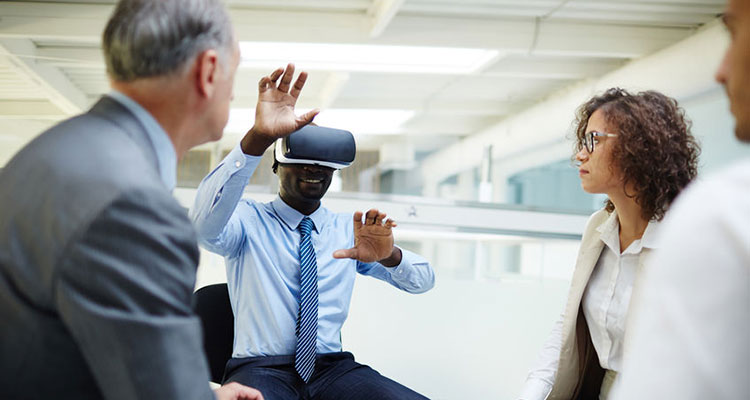AV=Actual/Virtual
 Last week, I attended Oculus Connect, the conference for Facebook/Oculus virtual reality developers.
Last week, I attended Oculus Connect, the conference for Facebook/Oculus virtual reality developers.
It was one of the best glimpses I have yet seen into the uses of a new technology that will change the way we do business in industries with events or communication and collaboration with remote people (rental and staging, collaboration, education, corporate). Not replace it, mind you, but definitely change it.
As many of my readers and colleagues know, I have been chasing VR and its effects on our business for many years, and especially how it would affect meetings. In the late ’80s and early ’90s, I wound up hopping around the world several times, doing data display systems for pioneering companies like Evans & Sutherland and Silicon Graphics, the makers of powerful graphics computers we then referred to as “workstations.” The executives I often traveled with would constantly talk about the days when powerful 3D computers would network together over unbelievably high bandwidth connections, allowing the users to participate in a future three-dimensional world they referred to as “virtual reality.” Since that time, I have kept a foothold in the world of VR development, mostly using VR environments for modeling setups for live events and facilities for clients and dabbling in developing VR environments for training and meetings.
So I spent the last few weeks really looking forward to the convention, signing up for a number of side meetings and sharing rumors with friends about what would be revealed at the keynote sessions, which would be kicked off by Facebook’s founder, Mark Zuckerberg, and his plan to create a billion social VR users.
Since I was pre-registered, I was able to go directly into the event, where I almost immediately ran into a number of colleagues from across the country, as you normally do at events like these. We milled around together, chatting for a bit before taking our seats as the keynote was about to begin.
The keynote was fascinating, as Oculus partners from major developers showed off upcoming applications, from the next generation of gaming to graphics and CAD applications that were designed to allow building from inside VR. At a convenient break, a number of us excitedly discussed the possibilities and then I decided to get a cup of coffee before the meetings resumed.
But rather than line up at the Convention Center Starbucks, I just took off my Oculus HMD and went downstairs to my own kitchen and poured myself a cup.
I’ll bet you saw that coming. Yes, I attended the keynote (and met with several other groups) entirely in virtual reality.
Now, I have spent a lot of years staging keynote presentations, so I thought this would make a good comparison with my real-world attendance at many events like this, which might allow me to make a better judgement on how this might affect our collective future.
Before I go on into the experience itself, let me tell those techies among you how I attended. For my morning meetings and breakouts, I was on a development-level system, an i7 based Windows 10 Pro machine with a loaded GTX1080 GPU, using an Oculus Rift HMD with a full hand control system. But to attend the keynote and sit in the audience, I switched to an Oculus Go, a $249 self-contained wireless HMD that runs on Android and requires no PC. I did this so I could see the difference between the high-level system and one the average meeting attendee or event attendee might use.
Anyway, as I mentioned, I have staged (and attended) many of these types of events and delivered many by videoconference or webcast. So let me compare attending the event in virtual reality both to live attendance and to telepresence or webcasting.
Attending an event in person is almost always the best experience. Communication with other humans is always at its deepest when you are with them. Casual encounters often produce important contacts. Chance conversations can turn into important conferences. Plus, the in-person event experience is much more realistic than any other method. Obviously.
The downside of attending an event like this in person? We all know it. Inconvenience, expense, travel time, etc. Very little of the expense, time and effort of attending an event have anything to do with the event itself. They have to do with getting there, survival while there and then getting home. Surly crowds, airport delays, packed flights and overbooked hotels all contribute to the fact that very few of us still consider business travel a perk.
But the event itself is necessary. The new products, the latest techniques and the business opportunities must be sought out. So we turn to telepresence and webcasting.
Webcasts (and their pseudo-interactive cousin, the webinar) diminish the motivational impact of events like this by making you a one-person audience. Yes, you may see shots that indicate other people are in the audience too, but you can’t easily or fully interact with them. There are no chance conversations, no meeting up with other colleagues. It’s like being forced to look at the stage with blinders on to the rest of the event. And you seriously wonder if the other web attendees are secretly doing their email, too. The content is there, but the EVENT is not.
Telepresence (or what most of us still call videoconferencing) improved on this by making more of the communication two-way, but still removes the element of spontaneity and of most individualized contact within the group. In other words, you can’t start a side conversation with the person sitting next to you or quietly meet a friend out in the hall during a coffee break. One symptom of this lack of in-person interaction is the number of times you now see people who are in the same videoconference also texting each other.
What VR can restore is the feeling of the attendee’s independence in the environment, what McLuhan called “presence.” Where teleconferencing and webcasting give you a camera’s view of what is going on someplace else, in a VR environment each person is a separate participant, able to associate with others and with the presenter in a more individualized way.
In general, the potential of VR is only now being really discovered and much of the technology is still being tinkered with. VR as it is now makes me think of an old anecdote about a circus bear — the amazing thing about the circus bear is not how well it dances, but that it dances at all.
And we are out of space for this month — stay tuned for next month when we will walk through the event itself.




